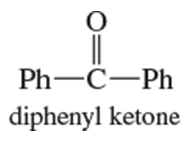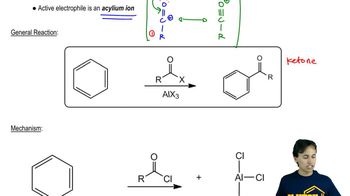Here are the essential concepts you must grasp in order to answer the question correctly.
Friedel–Crafts Acylation
Friedel–Crafts acylation is an electrophilic aromatic substitution reaction that introduces an acyl group into an aromatic ring. This reaction typically uses an acyl chloride and a Lewis acid catalyst, such as aluminum chloride, to form a ketone. The acyl group enhances the reactivity of the aromatic compound, allowing for further functionalization. Understanding this reaction is crucial for synthesizing complex aromatic compounds.
Recommended video:
Clemmensen Reduction
The Clemmensen reduction is a chemical reaction that reduces carbonyl groups (aldehydes and ketones) to methylene groups (alkanes) using zinc amalgam and hydrochloric acid. This reaction is particularly useful in organic synthesis when the carbonyl compound is sensitive to other reducing conditions. Recognizing when to apply this reduction is essential for modifying aromatic compounds after acylation.
Recommended video:
Gatterman–Koch Synthesis
The Gatterman–Koch synthesis is a method for introducing formyl groups into aromatic compounds via the reaction of an aromatic compound with carbon monoxide and hydrochloric acid in the presence of a Lewis acid catalyst. This reaction is significant for synthesizing aldehydes from aromatic substrates, providing a pathway to further functionalization. Mastery of this synthesis is important for constructing complex aromatic systems.
Recommended video:
Synthesis of Amino Acids: Strecker Synthesis Example 1

 Verified step by step guidance
Verified step by step guidance Verified video answer for a similar problem:
Verified video answer for a similar problem:



 5:20m
5:20m